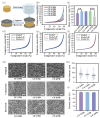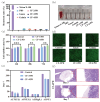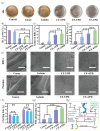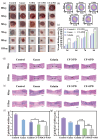Biodegradable and Mechanically Resilient Recombinant Collagen/PEG/Catechol Cryogel Hemostat for Deep Non-Compressible Hemorrhage and Wound Healing
- PMID: 40558744
- PMCID: PMC12192300
- DOI: 10.3390/gels11060445
Biodegradable and Mechanically Resilient Recombinant Collagen/PEG/Catechol Cryogel Hemostat for Deep Non-Compressible Hemorrhage and Wound Healing
Abstract
Traumatic non-compressible hemorrhage and subsequent wound management remain critical challenges in military and civilian settings to this day. Cryogels have emerged as promising hemostatic materials for non-compressible hemorrhage due to their blood-triggered shape recovery. In this study, a biodegradable and mechanically resilient cryogel (CF/PD) was produced via cryopolymerization, employing methacrylated recombinant collagen as a macromolecular crosslinker alongside poly (ethylene glycol) diacrylate (PEGDA) and dopamine methacrylate (DMA). With its interpenetrating macro-porous structure and high hydrophilicity, the CF/PD rapidly absorbs blood and returns to its original shape within 1.5 s. In a rat liver defect model, CF/PD outperformed commercially available gelatin sponges, reducing hemostasis time by 74.4% and blood loss by 76.5%. Moreover, CF/PD cryogels facilitate in situ tissue regeneration by virtue of the bioactivity and degradability of recombinant collagen. This work establishes a bioactive recombinant collagen-driven cryogel platform, offering a transformative solution for managing non-compressible hemorrhage while enabling tissue regeneration.
Keywords: cryogel; hemostasis; recombinant collagen CF-1552; shape memory recovery; wound healing.
Conflict of interest statement
Author Ru Xu was employed by the company Xi’an Giant Biogene Technology Co., Ltd. The remaining authors declare that the research was conducted in the absence of any commercial or financial relationships that could be construed as a potential conflict of interest.
Figures








Similar articles
-
Fast expandable polysaccharide-based cryogel derived from mushroom for noncompressible bleeding.Int J Biol Macromol. 2025 Aug;319(Pt 3):145542. doi: 10.1016/j.ijbiomac.2025.145542. Epub 2025 Jun 25. Int J Biol Macromol. 2025. PMID: 40578649
-
Catechol-polysaccharide complex enhancing the detachment and blood coagulation of polyvinyl alcohol/chitosan cryogel for non-compressible bleeding.Int J Biol Macromol. 2025 Jul;318(Pt 4):145281. doi: 10.1016/j.ijbiomac.2025.145281. Epub 2025 Jun 17. Int J Biol Macromol. 2025. PMID: 40532994
-
Injectable hydrogels based on mussel-inspired nanocomposite microspheres for non-compressible intra-abdominal hemorrhage control.Theranostics. 2025 Jul 28;15(16):8509-8530. doi: 10.7150/thno.118901. eCollection 2025. Theranostics. 2025. PMID: 40860142 Free PMC article.
-
Exercise versus airway clearance techniques for people with cystic fibrosis.Cochrane Database Syst Rev. 2022 Jun 22;6(6):CD013285. doi: 10.1002/14651858.CD013285.pub2. Cochrane Database Syst Rev. 2022. PMID: 35731672 Free PMC article.
-
Antibiotics and antiseptics for surgical wounds healing by secondary intention.Cochrane Database Syst Rev. 2016 Mar 29;3(3):CD011712. doi: 10.1002/14651858.CD011712.pub2. Cochrane Database Syst Rev. 2016. PMID: 27021482 Free PMC article.
References
LinkOut - more resources
Full Text Sources

